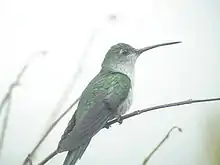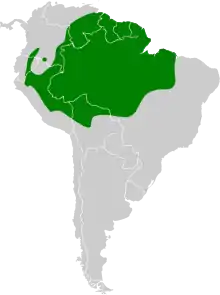Grey-breasted sabrewing
The grey-breasted sabrewing (Campylopterus largipennis) is a species of hummingbird in the family Trochilidae.
| Grey-breasted sabrewing | |
|---|---|
 | |
| Grey-breasted sabrewing in Ecuador. | |
| Scientific classification | |
| Kingdom: | Animalia |
| Phylum: | Chordata |
| Class: | Aves |
| Order: | Apodiformes |
| Family: | Trochilidae |
| Genus: | Campylopterus |
| Species: | C. largipennis |
| Binomial name | |
| Campylopterus largipennis (Boddaert, 1783) | |
 | |
It is found in humid forest in the Guianas and the Amazon Basin with a smaller disjunct population (subspecies diamantinensis) in forest and woodland in Bahia and Minas Gerais in eastern Brazil.
A relatively large hummingbird with grey underparts and broad white tail-tips, it is generally common.
Taxonomy
The grey-breasted sabrewing was described by the French polymath Georges-Louis Leclerc, Comte de Buffon in 1780 in his Histoire Naturelle des Oiseaux from a specimen collected in Cayenne, French Guiana.[2] The bird was also illustrated in a hand-coloured plate engraved by François-Nicolas Martinet in the Planches Enluminées D'Histoire Naturelle which was produced under the supervision of Edme-Louis Daubenton to accompany Buffon's text.[3] Neither the plate caption nor Buffon's description included a scientific name but in 1783 the Dutch naturalist Pieter Boddaert coined the binomial name Trochilus largipennis in his catalogue of the Planches Enluminées.[4] The grey-breasted sabrewing is now placed in the genus Campylopterus that was erected by the English naturalist William Swainson in 1827.[5][6] The generic name combines the Ancient Greek kampulos meaning "curved" or "bent" and -pteros meaning "-winged". The specific epithet largipennis combines the Latin largus meaning "ample" and -pennis meaning "-winged".[7]
Subspecies
Four subspecies are recognised:[6]
References
- BirdLife International (2012). "Campylopterus largipennis". IUCN Red List of Threatened Species. 2012. Retrieved 26 November 2013.CS1 maint: ref=harv (link)
- Buffon, Georges-Louis Leclerc de (1780). "L'oiseau-mouche à larges tuyaux". Histoire Naturelle des Oiseaux (in French). Volume 11. Paris: De L'Imprimerie Royale. p. 48.
- Buffon, Georges-Louis Leclerc de; Martinet, François-Nicolas; Daubenton, Edme-Louis; Daubenton, Louis-Jean-Marie (1765–1783). "Oiseau-mouche à larges tuyaux, de Cayenne". Planches Enluminées D'Histoire Naturelle. Volume 7. Paris: De L'Imprimerie Royale. Plate 672 Fig. 2.
- Boddaert, Pieter (1783). Table des planches enluminéez d'histoire naturelle de M. D'Aubenton : avec les denominations de M.M. de Buffon, Brisson, Edwards, Linnaeus et Latham, precedé d'une notice des principaux ouvrages zoologiques enluminés (in French). Utrecht. p. 41, Number 672 Fig. 2.
- Swainson, William John (1827). "On several groups and forms in ornithology, not hitherto defined". Zoological Journal. 3: 343-363 [358].
- Gill, Frank; Donsker, David, eds. (2019). "Hummingbirds". World Bird List Version 9.2. International Ornithologists' Union. Retrieved 21 July 2019.
- Jobling, James A. (2010). The Helm Dictionary of Scientific Bird Names. London: Christopher Helm. pp. 87, 219. ISBN 978-1-4081-2501-4.
- Lopes, L.E.; De Vasconcelos, M.F.; Gonzaga, L.P. (2017). "A cryptic new species of hummingbird of the Campylopterus largipennis complex (Aves: Trochilidae)". Zootaxa. 4268 (1): 1–33. doi:10.11646/zootaxa.4268.1.1.
External links
- Grey-breasted sabrewing videos on the Internet Bird Collection
- Stamps (with RangeMap)-for Suriname
- photo; Article Colombia Curiosa and Oiseaux.net
- Grey-breasted sabrewing photo; RangeMap & synopsis InfoNatura NatureServe
- "Gray-breasted sabrewing" photo gallery VIREO Photo-High Res
